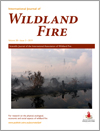International Journal of Wildland Fire
Volume 28
Number 3 2019
Two recent wildfires at the Great Dismal Swamp, USA, burned deep into organic-rich soils and released large amounts of carbon, thus motivating hydrologic restoration efforts. Our study examined hydrologic controls on soil properties and associated fire vulnerability to inform fire management and prediction at the Great Dismal Swamp and other peatlands.
This experimental study investigates the relationship between fuel type, moisture content, energy released and emissions during combustion of wildland fuels. It is found that dry fuels maintain a direct relationship between energy released and emissions, whereas moist fuels do not follow these trends and are in need further study.
We examined fuel bed ignitibility in Eucalyptus forests. Field data from prescribed burns were used to model ignition probability as a function of fuel bed attributes. Surface fine-fuel moisture content and overall fuel hazard were the strongest predictors of the likelihood of ignition.
Uncertainty analysis in this study shows that neglecting fuel-model parameter uncertainty of the model would magnify fire behaviours. This emphasises the importance of considering fuel-model parameter uncertainty when simulating wildfire behaviours. The highly uncertain fuel-model parameters with highly temporal and spatial variability are preferentially chosen as parameters to adjust the calibration against several actual fires and to effectively improve the fire-prediction capabilities of fuel models. Moreover, the results of fuel-model parameter uncertainty analysis advance the fuel-model classification in boreal forests.
During the largest wildfire in the history of the south-western USA, thinning treatments on federal forest lands adjacent to private land in the Alpine and Nutrioso, Arizona, USA, communities significantly changed forest structure and fire severity.
We infer energy incident on in situ (in-flame) sensors from energy measured using nadir (overhead) sensors borne on towers and a piloted aircraft for surface fires in non-forested sites and longleaf pine (Pinus palustris) savanna. We predict turkey oak (Quercus laevis) stem mortality from inferred incident energy.
Wildfires are one of the main causes of forest destruction and ecological disasters. By using auxiliary variables and past data, this work introduces temporal regression models for explaining and predicting the number of fires in forest areas during a given time period. The new methodology is an interesting tool to implement preventive policies and to support the design of more effective measures against fires.
Identifying breakpoints in fire danger metrics is critical for various applications. We show that the widespread cumulative burnt area method can lead to spurious breakpoints and recommend that previous datasets be reanalysed.





